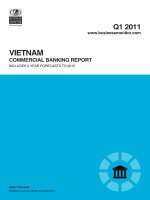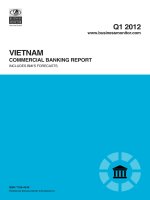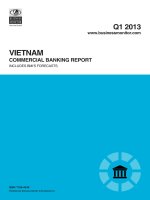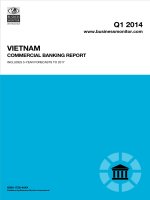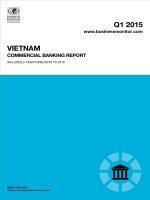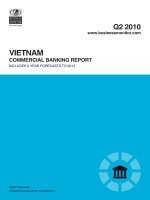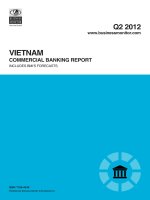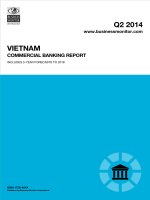Vietnam commercial banking report q1 2014
Bạn đang xem bản rút gọn của tài liệu. Xem và tải ngay bản đầy đủ của tài liệu tại đây (559.11 KB, 80 trang )
Q1 2014
www.businessmonitor.com
VIETNAM
COMMERCIAL BANKING REPORT
INCLUDES 5-YEAR FORECASTS TO 2017
ISSN 1758-454X
Published by:Business Monitor International
Vietnam Commercial Banking
Report Q1 2014
INCLUDES 5-YEAR FORECASTS TO 2017
Part of BMI’s Industry Report & Forecasts Series
Published by: Business Monitor International
Copy deadline: November 2013
Business Monitor International
Senator House
85 Queen Victoria Street
London
EC4V 4AB
United Kingdom
Tel: +44 (0) 20 7248 0468
Fax: +44 (0) 20 7248 0467
Email:
Web:
© 2013 Business Monitor International
All rights reserved.
All information contained in this publication is
copyrighted in the name of Business Monitor
International, and as such no part of this
publication may be reproduced, repackaged,
redistributed, resold in whole or in any part, or used
in any form or by any means graphic, electronic or
mechanical, including photocopying, recording,
taping, or by information storage or retrieval, or by
any other means, without the express written consent
of the publisher.
DISCLAIMER
All information contained in this publication has been researched and compiled from sources believed to be accurate and reliable at the time of
publishing. However, in view of the natural scope for human and/or mechanical error, either at source or during production, Business Monitor
International accepts no liability whatsoever for any loss or damage resulting from errors, inaccuracies or omissions affecting any part of the
publication. All information is provided without warranty, and Business Monitor International makes no representation of warranty of any kind as
to the accuracy or completeness of any information hereto contained.
CONTENTS
BMI Industry View 7
Table: Commercial Banking Sector Indicators 7
Table: Commercial Banking Sector Key Ratios, February 2013 7
Table: Annual Growth Rate Projections 2012-2017 (%) 7
Table: Ranking Out Of 70 Countries Reviewed In 2013 8
Table: Commercial Banking Sector Indicators, 2010-2017 8
SWOT 9
Commercial Banking 9
Political 10
Economic 11
Business Environment 12
Industry Forecast 13
Industry Risk Reward Ratings 18
Asia Commercial Banking Risk/Reward Ratings 18
Table: Asia Commercial Banking Risk/Reward Ratings 19
Market Overview 20
Asia Commercial Banking Outlook 20
Table: Banks' Bond Portfolios, 2012 20
Table: Comparison of Loan/Deposit & Loan/Asset & Loan/GDP ratios, 2013 20
Table: Comparison of Total Assets & Client Loans & Client Deposits (US$bn) 21
Table: Comparison of US$ Per Capita Deposits, 2013 22
Economic Analysis 22
Table: Vietnam - Economic Activity 26
Competitive Landscape 27
Market Structure 27
Protagonists 27
Table: Protagonists In Vietnam's Commercial Banking Sector 27
Definition Of The Commercial Banking Universe 27
List Of Banks 28
Table: Financial Institutions In Vietnam 28
Company Profile 31
Agribank 31
Table: Balance Sheet (VNDmn) 32
Table: Balance Sheet (US$mn) 33
Table: Key Ratios (%) 33
Asia Commercial Bank 34
Table: Stock Market Indicators 35
Table: Balance Sheet (VNDmn) 36
Vietnam Commercial Banking Report Q1 2014
© Business Monitor International Page 4
Table: Balance Sheet (US$mn) 36
Table: Key Ratios (%) 36
Bank for Foreign Trade of Vietnam (Vietcombank) 37
Table: Stock Market Indicator 39
Table: Balance Sheet (VNDmn) 39
Table: Balance Sheet (US$mn) 39
Table: Key Ratios (%) 40
Eximbank 41
Table: Stock Market Indicators 42
Table: Balance Sheet (VNDmn) 43
Table: Balance Sheet (US$mn) 43
Table: Key Ratios (%) 43
Housing Development Commercial Joint Stock Bank (HDBank) 44
Sacombank 46
Table: Stock Market Indicators 48
Table: Balance Sheet (VNDmn) 48
Table: Balance Sheet (US$mn) 49
Table: Key Ratios (%) 49
VietinBank 50
Table: Stock Market Indicators 52
Table: Balance Sheet (VNDmn) 52
Table: Balance Sheet (US$mn) 52
Table: Key Ratios (%) 53
Regional Overview 54
Asia Overview 54
China 54
India 55
Indonesia 56
Philippines 57
Vietnam 58
Singapore 59
South Korea 60
Global Industry Overview 62
Global Commercial Banking Outlook 62
Demographic Forecast 71
Demographic Outlook 71
Table: Vietnam's Population By Age Group, 1990-2020 ('000) 72
Table: Vietnam's Population By Age Group, 1990-2020 (% of total) 73
Table: Vietnam's Key Population Ratios, 1990-2020 74
Table: Vietnam's Rural And Urban Population, 1990-2020 74
Methodology 75
Industry Forecast Methodology 75
Sector Specific Methodology 76
Risk/Reward Ratings Methodology 77
Vietnam Commercial Banking Report Q1 2014
© Business Monitor International Page 5
Sector Specific Methodology 78
Table: Commercial Banking Risk/Reward Rating Indicators 78
Weighting 79
Table: Weighting Of Indicators 79
Vietnam Commercial Banking Report Q1 2014
© Business Monitor International Page 6
BMI Industry View
Table: Commercial Banking Sector Indicators
Date
Total
assets
Client
loans
Bond
portfolio Other
Liabilities
and
capital Capital
Client
deposits Other
February 2012, VNDbn 3,388,150 2,772,420 278,421 337,309 3,388,150 560,003 2,483,817 344,330
February 2013, VNDbn 3,930,528 3,070,100 497,352 363,076 3,930,528 588,974 3,169,132 172,422
% change y-o-y 16.0% 10.7% 78.6% 7.6% 16.0% 5.2% 27.6% -49.9%
February 2012, US$bn 162.6 133.1 13.4 16.2 162.6 26.9 119.2 16.5
February 2013, US$bn 187.6 146.5 23.7 17.3 187.6 28.1 151.2 8.2
% change y-o-y 15.3% 10.1% 77.6% 7.0% 15.3% 4.6% 26.9% -50.2%
Source: BMI; Central banks; Regulators
Table: Commercial Banking Sector Key Ratios, February 2013
Loan/deposit ratio
Loan/asset ratio Loan/GDP ratio GDP Per Capita, US$
Deposits per capita,
US$
96.88% 78.11% 101.81% 1,762.5 1,682.5
Falling Falling Falling n.a. n.a.
Source: BMI; Central banks; Regulators
Table: Annual Growth Rate Projections 2012-2017 (%)
Assets Loans Deposits
Annual Growth Rate 11 9 6
CAGR 13 11 8
Ranking 22 27 41
Source: BMI; Central banks; Regulators
Vietnam Commercial Banking Report Q1 2014
© Business Monitor International Page 7
Table: Ranking Out Of 70 Countries Reviewed In 2013
Loan/deposit ratio Loan/asset ratio Loan/GDP ratio
9 1 16
Local currency asset growth Local currency loan growth Local currency deposit growth
20 23 27
Source: BMI; Central banks; Regulators
Table: Commercial Banking Sector Indicators, 2010-2017
2010 2011 2012e 2013f 2014f 2015f 2016f 2017f
Total assets, VNDbn 2,953,153 3,437,893 3,816,061 4,350,310 4,959,353 5,604,069 6,276,557 6,966,979
Total assets, US$bn 151.5 163.4 183.1 208.1 241.2 275.7 312.3 348.3
Client loans, VNDbn 2,475,540 2,829,890 3,084,580 3,454,730 3,869,297 4,294,920 4,724,412 5,149,609
Client loans, US$bn 127.0 134.5 148.0 165.3 188.1 211.3 235.0 257.5
Client deposits, VNDbn 2,209,896 2,483,357 2,706,859 2,977,545 3,245,524 3,505,166 3,750,528 3,975,560
Client deposits, US$bn 113.3 118.1 129.9 142.5 157.8 172.4 186.6 198.8
e/f = estimate/forecast. Source: BMI; Central banks; Regulators
Vietnam Commercial Banking Report Q1 2014
© Business Monitor International Page 8
SWOT
Commercial Banking
Vietnam Commercial Banking SWOT
Strengths
■
Untapped market with potential for increased participation of foreign banks.
■
Large population with a high savings rate and potential for income growth.
■
The Vietnamese government aims to speed up the process of privatising state-owned
banks, which will help modernise the industry.
■
State-owned banks will play a lesser role going forward, and the risks associated with
state-directed lending will decrease over time.
Weaknesses
■
Domestic banks continue to lag behind their foreign peers in terms of financial
strength and the technological curve.
■
Accounting standards lag far behind international standards and the lack of
transparency entails significant risks for foreign investors.
■
Small banks have an overwhelming exposure to real estate and individual loans,
resulting in highly skewed and risky loan portfolios.
Opportunities
■
The population is still underbanked, with significant potential for adopting cash-free
payment systems and new mobile banking technologies.
■
Rising income levels and deepening capital markets could give rise to opportunities in
more sophisticated financial products and growth for the local asset management
industry.
Threats
■
Track record of macroeconomic instability threatens the credibility of the government
and could potentially drive economic policy away from further liberalisation.
■
The high level of government debt risks triggering a fiscal crisis, undermining
confidence in the banking sector.
Vietnam Commercial Banking Report Q1 2014
© Business Monitor International Page 9
Political
SWOT Analysis
Strengths
■
The Communist Party of Vietnam remains committed to market-oriented reforms and
we do not expect major shifts in policy direction over the next five years. The one-
party system is generally conducive to short-term political stability.
■
Relations with the US have witnessed a marked improvement, and Washington sees
Hanoi as a potential geopolitical ally in South East Asia.
Weaknesses
■
Corruption among government officials poses a major threat to the legitimacy of the
ruling Communist Party.
■
There is increasing (albeit still limited) public dissatisfaction with the leadership's tight
control over political dissent.
Opportunities
■
The government recognises the threat corruption poses to its legitimacy, and has
acted to clamp down on graft among party officials.
■
Vietnam has allowed legislators to become more vocal in criticising government
policies. This is opening up opportunities for more checks and balances within the
one-party system.
Threats
■
Macroeconomic instabilities continue to weigh on public acceptance of the one-party
system, and street demonstrations to protest economic conditions could develop into
a full-on challenge of undemocractic rule.
■
Although strong domestic control will ensure little change to Vietnam's political scene
in the next few years, over the longer term, the one-party-state will probably be
unsustainable.
■
Relations with China have deteriorated over recent years due to Beijing's more
assertive stance over disputed islands in the South China Sea and domestic criticism
of a large Chinese investment into a bauxite mining project in the central highlands,
which could potentially cause wide-scale environmental damage.
Vietnam Commercial Banking Report Q1 2014
© Business Monitor International Page 10
Economic
SWOT Analysis
Strengths
■
Vietnam has been one of the fastest-growing economies in Asia in recent years, with
GDP growth averaging 7.1% annually between 2000 and 2012.
■
The economic boom has lifted many Vietnamese out of poverty, with the official
poverty rate in the country falling from 58% in 1993 to 20.7% in 2012.
Weaknesses
■
Vietnam still suffers from substantial trade and fiscal deficits, leaving the economy
vulnerable to global economic uncertainties. The fiscal deficit is dominated by
substantial spending on social subsidies that could be difficult to withdraw.
■
The heavily-managed and weak currency reduces incentives to improve quality of
exports, and also keeps import costs high, contributing to inflationary pressures.
Opportunities
■
WTO membership and the upcoming ASEAN AEC in 2015 should give Vietnam
greater access to both foreign markets and capital, while making Vietnamese
enterprises stronger through increased competition.
■
The government will in spite of the current macroeconomic woes, continue to move
forward with market reforms, including privatisation of state-owned enterprises, and
liberalising the banking sector.
■
Urbanisation will continue to be a long-term growth driver. The UN forecasts the
urban population rising from 29% of the population to more than 50% by the early
2040s.
Threats
■
Inflation and deficit concerns have caused some investors to re-assess their hitherto
upbeat view of Vietnam. If the government focuses too much on stimulating growth
and fails to root out inflationary pressure, it risks prolonging macroeconomic
instability, which could lead to a potential crisis.
■
Prolonged macroeconomic instability could prompt the authorities to put reforms on
hold as they struggle to stabilise the economy.
Vietnam Commercial Banking Report Q1 2014
© Business Monitor International Page 11
Business Environment
SWOT Analysis
Strengths
■
Vietnam has a large, skilled and low-cost workforce, which has made the country
attractive to foreign investors.
■
Vietnam's location - its proximity to China and South East Asia, and its good sea links
- makes it a good base for foreign companies to export to the rest of Asia, and
beyond.
Weaknesses
■
Vietnam's infrastructure is still weak. Roads, railways and ports are inadequate to
cope with the country's economic growth and links with the outside world.
■
Vietnam remains one of the world's most corrupt countries. According to
Transparency International's 2012 Corruption Perceptions Index, Vietnam ranks 123
out of 176 countries.
Opportunities
■
Vietnam is increasingly attracting investment from key Asian economies, such as
Japan, South Korea and Taiwan. This offers the possibility of the transfer of high-tech
skills and know-how.
■
Vietnam is pressing ahead with the privatisation of state-owned enterprises and the
liberalisation of the banking sector. This should offer foreign investors new entry
points.
Threats
■
Ongoing trade disputes with the US, and the general threat of American
protectionism, which will remain a concern.
■
Labour unrest remains a lingering threat. A failure by the authorities to boost skills
levels could leave Vietnam a second-rate economy for an indefinite period.
Vietnam Commercial Banking Report Q1 2014
© Business Monitor International Page 12
Industry Forecast
BMI View: Government efforts to liberalise the banking sector by allowing for more foreign competition
are likely to result in intense competition over the coming years. We expect foreign banks to gain market
share steadily while local small-to-medium sized banks are likely to undergo rapid consolidation over this
period. We believe that foreign banks that have already established a strong foothold in Vietnam are in
strong position to emerge as key dominant players within the banking sector towards the final stages of the
restructuring process.
The Vietnamese government's push to liberalise the banking sector is set to present significant challenges
for local banks as competition intensifies over the coming years. We believe that foreign banks, which
typically are more technologically advanced and are financially stronger than local banks will gain market
share steadily over the next five years. Meanwhile, we expect to see rapid consolidation among local small-
to-medium sized banks over this period. This is in line with the State Bank of Vietnam (SBV)'s
restructuring plan (introduced in 2011) to consolidate the banking sector and reduce the number of small
and financially-weak credit institutions that are struggling to compete effectively.
Vietnam Commercial Banking Report Q1 2014
© Business Monitor International Page 13
First-Mover Advantage
Vietnam - Number Of Banks By Category
Source: BMI, State Bank Of Vietnam
Rising Number Of Foreign Banks
According to figures published by the SBV, there were a total of 39 local banks at the end of 2012, five of
which are state-owned and the remaining 34 being joint-stock banks (see chart). Over the years, we have
witnessed a steady increase in the number of foreign bank branches being established in Vietnam, and we
expect this trend to accelerate. Although the range of services that foreign banks are currently providing are
limited (mainly the provision of banking services and financial solutions for multi-national companies), we
believe that further regulatory reforms will eventually open up new markets for foreign banks. Indeed, the
Vietnamese government is considering plans to ramp up efforts to liberalise the retail market by allowing
foreign banks to provide more sophisticated financial products and banking services over the coming years.
Vietnam Commercial Banking Report Q1 2014
© Business Monitor International Page 14
Ample Room For Improvement
Vietnam - Components Of Financial Market Development Index (2012-2013)
Source: BMI, World Economic Forum
Rapid Consolidation Among Local Banks
We highlight that the retail market remains largely untapped and we believe that foreign banks with a
genuine competitive advantage over the smaller local banks are likely to be successful at penetrating this
market and taking a sizeable market share within a short period of time. This is likely to force some of the
small ailing banks to exit the market altogether or to be merged with a larger bank, which is in line with our
view that the banking sector will undergo rapid consolidation over the coming years. The Vietnamese
government is also supportive of a speedy restructuring of the banking sector by allowing for more foreign
competition, and has announced plans to reduce the total number of local banks to 15-17 by 2015.
Although we expect this structural transformation to result in an increasingly volatile business environment
and lead to intense competition, we view it as a necessary evolutionary process that will ultimately shape
Vietnam's banking sector into a more robust and highly competitive industry relative to the region.
Moreover, given that local banks that are laden with bad-debt remain reluctant to extent loans to businesses,
Vietnam Commercial Banking Report Q1 2014
© Business Monitor International Page 15
allowing foreign banks with stronger balance sheets to enter the market is a logical solution to complement
government efforts to revive credit growth and the economy.
Positioning For The Recovery
Vietnam - Outstanding Credit, VNDbn (LHS) & % chg y-o-y (RHS)
Source: BMI, State Bank of Vietnam
The Emerging Winners
Over the years, establishing joint ventures with local banks have been the preferred strategy for foreign
banks seeking to penetrate the Vietnamese market. However, given that many local banks that have a well-
established market share have already entered into some form of a partnership agreement or joint venture
with a foreign bank, new foreign entrants are likely to face intense competition and increasingly
overwhelming barriers to entry. Indeed, we believe that foreign banks that have undertaken an enormous
amount of risk by expanding aggressively into Vietnam (despite the turbulent economic conditions in recent
years) will be heavily rewarded as a result of their first mover advantage. As of the end of 2012, there were
only five fully foreign-owned banks - HSBC, Standard Chartered Bank, Shinhan Bank, ANZ and
Citibank. Thus, despite the threat of more foreign competition, we believe that the abovementioned banks
Vietnam Commercial Banking Report Q1 2014
© Business Monitor International Page 16
are likely to emerge as the key dominant players within the banking sector towards the final stages of the
restructuring process.
Vietnam Commercial Banking Report Q1 2014
© Business Monitor International Page 17
Industry Risk Reward Ratings
Asia Commercial Banking Risk/Reward Ratings
Commercial Banking Risk/Reward Rating Methodology
Since Q108, we have described numerically the banking business environment for each of the countries
analysed by BMI. We do this through our Commercial Banking Industry Risk/Reward Rating (IRR), a
measure that ensures we capture the latest quantitative information available. It also ensures consistency
across all countries. Like all of BMI's Industry Risk/Reward Ratings, its takes into account the Rewards on
offer within the banking sector in a given country, but also the Risks to investors being able to realise those
opportunities. The overall Rating is weighted 70% towards Rewards and 30% towards Risks.
Within the Rewards category, we look at factors that are specific to the banking industry (accounting for
60% of the score within this category), and elements that relate to that country in general (accounting for
40% of the weighting). These include, but are not limited to, total assets, asset and loan growth, GDP and
taxation. Likewise on the Risks side, we look at industry-specific Risks (weighted 40% of the Risks total)
and country-specific Risks (weighted 60%). These include, but are not limited to, the regulatory framework
and environment, the competitive environment, financial risk, legal risk and policy continuity.
In general three aspects need to be borne in mind when interpreting the IRRs. The first is that the Industry
Rewards element is the most heavily weighted of the four elements, accounting for 42% (60% of 70%) of
the overall Rating. Second, if the Industry Rewards score is significantly higher than the Country Rewards
score, within the Rewards category, it usually implies that the banking sector is (very) large and/or
developed relative to the general wealth, stability and financial infrastructure in the country. Conversely, if
the industry score is significantly lower, it usually means that the banking sector is small and/or
underdeveloped relative to the general wealth, stability and financial infrastructure in the country. Third,
within the Risks category, the industry-specific elements (i.e. how regulations affect the development of the
sector, how regulations affect competition within it, and Moody's Investor Services' ratings for local
currency deposits) can be markedly different from BMI's long-term Country Risk rating for a given market.
Vietnam Commercial Banking Report Q1 2014
© Business Monitor International Page 18
Table: Asia Commercial Banking Risk/Reward Ratings
Limits of Potential Returns Risks to Potential Returns Overall
Market Structure Country Structure Market Risks Country Risks Rating Ranking
Bangladesh 50.0 45.0 43.3 44.0 46.7 53
China 93.3 57.5 63.3 74.0 76.2 15
Hong Kong 80.0 92.5 73.3 78.0 82.3 7
India 83.3 57.5 60.0 54.0 68.0 30
Indonesia 76.7 65.0 80.0 52.0 69.4 28
Japan 33.3 77.5 66.7 80.0 58.1 36
Malaysia 73.3 80.0 83.3 80.0 77.6 12
Pakistan 43.3 50.0 53.3 42.0 46.2 58
Philippines 50.0 62.5 60.0 58.0 56.1 41
Singapore 66.7 95.0 96.7 90.0 82.4 6
Sri Lanka 30.0 55.0 33.3 46.0 40.3 61
South Korea 80.0 85.0 83.3 76.0 81.1 8
Taiwan 76.7 72.5 86.7 76.0 76.6 14
Thailand 66.7 65.0 86.7 74.0 69.9 23
Vietnam 60.0 55.0 36.7 48.0 53.6 46
United States 93.3 85.0 100.0 80.0 89.4 1
Scores out of 100, with 100 the highest. Source: BMI
Vietnam Commercial Banking Report Q1 2014
© Business Monitor International Page 19
Market Overview
Asia Commercial Banking Outlook
Table: Banks' Bond Portfolios, 2012
Bond Portfolio, US$bn Bond as % total assets Year-on-year growth %
Bangladesh 20.0 22.5 13.9
China 1,833.1 8.5 15.0
Hong Kong 379.3 19.8 8.1
India 352.2 25.8 14.3
Indonesia* 17.3 4.3 17.7
Japan 3,123.6 30.7 3.4
Malaysia 87.4 14.5 24.3
Pakistan 41.5 42.9 33.7
Philippines* 35.4 23.7 -4.3
Singapore* 76.5 11.6 5.5
Sri Lanka 5.1 17.3 25.5
South Korea* 271.5 17.0 4.6
Taiwan* 98.0 8.4 -47.2
Thailand 82.1 17.0 21.4
Vietnam* 12.3 7.5 27.0
United States 237.7 1.8 40.1
Source: Central banks, regulators, BMI. *Only 2011 data available
Table: Comparison of Loan/Deposit & Loan/Asset & Loan/GDP ratios, 2013
Loan/Deposit
ratio % Rank Trend
Loan/Asset
ratio % Rank Trend
Loan/GDP
ratio % Rank Trend
Bangladesh 90.5 34 Falling 67.1 14 Falling 53.5 42 Rising
China 74.9 58 Falling 50.8 49 Rising 124.7 10 Falling
Hong Kong 67.8 65 Rising 37.8 64 Rising 270.9 2 Rising
India 80.0 50 Rising 67.0 16 Falling 57.2 40 Rising
Indonesia 83.3 44 Falling 62.5 24 Falling 34.8 54 Rising
Japan 69.8 64 Falling 48.0 54 Falling 91.8 19 Rising
Malaysia 79.0 51 Falling 59.4 33 Falling 120.9 12 Rising
Vietnam Commercial Banking Report Q1 2014
© Business Monitor International Page 20
Comparison of Loan/Deposit & Loan/Asset & Loan/GDP ratios, 2013 - Continued
Loan/Deposit
ratio % Rank Trend
Loan/Asset
ratio % Rank Trend
Loan/GDP
ratio % Rank Trend
Pakistan 61.8 67 Falling 41.3 63 Falling 20.2 64 Rising
Philippines 76.1 57 Rising 56.2 42 Rising 36.3 53 Rising
Singapore 103.7 19 Rising 59.0 34 Rising 151.9 6 Rising
Sri Lanka 83.8 43 Rising 61.4 28 Falling 31.5 56 Rising
South Korea 114.4 11 Falling 72.0 6 Falling 103.5 13 Falling
Taiwan 80.7 49 Rising 63.8 20 Rising 165.5 5 Rising
Thailand 98.1 26 Rising 66.4 17 Rising 85.5 21 Falling
Vietnam 116.0 9 Rising 79.4 1 Falling 103.5 14 Falling
United States 98.9 25 Falling 69.6 9 Falling 59.5 37 Falling
Source: Central banks, regulators, BMI
Table: Comparison of Total Assets & Client Loans & Client Deposits (US$bn)
2013 2012
Total Assets Client Loans Client Deposits Total Assets Client Loans Client Deposits
Bangladesh 111.0 74.5 82.3 88.8 59.6 65.0
China 22,342.2 11,349.2 15,143.8 21,549.8 10,740.2 14,197.2
Hong Kong 2,046.1 774.1 1,142.4 1,917.2 718.6 1,070.5
India 1,729.9 1,159.3 1,449.9 1,363.0 913.5 1,161.8
Indonesia 521.9 326.0 391.6 435.3 276.5 329.3
Japan 9,932.1 4,766.1 6,826.5 10,179.4 4,975.1 7,091.4
Malaysia 700.6 416.4 527.1 604.0 359.0 450.3
Pakistan 107.4 44.3 70.1 96.6 42.0 63.7
Philippines 181.0 101.8 133.7 170.4 90.4 125.3
Singapore 766.0 452.1 436.0 741.5 395.7 404.5
Sri Lanka 36.3 22.3 26.6 29.4 18.1 21.9
South Korea 1,710.1 1,231.7 1,076.7 1,798.8 1,295.6 1,112.3
Taiwan 1,316.4 840.1 1,040.5 1,264.4 787.9 999.3
Thailand 520.5 345.5 352.3 483.0 319.1 326.9
Vietnam 208.1 165.3 142.5 183.1 148.0 129.9
Vietnam Commercial Banking Report Q1 2014
© Business Monitor International Page 21
Comparison of Total Assets & Client Loans & Client Deposits (US$bn) - Continued
2013 2012
United States 14,191.1 9,875.5 9,982.1 13,139.9 9,777.7 9,329.1
Source: Central banks, regulators, BMI
Table: Comparison of US$ Per Capita Deposits, 2013
GDP Per Capita
Client Deposits, per
capita
Rich 20% Client
Deposits, per capita
Poor 80% Client
Deposits, per capita
Bangladesh 850 533 2,131 133
China 6,752 11,140 44,561 2,785
Hong Kong 39,277 157,054 628,217 39,264
India 1,589 1,137 4,548 284
Indonesia 3,811 1,584 6,337 396
Japan 41,985 54,030 216,122 13,508
Malaysia 11,365 17,696 70,783 4,424
Pakistan 1,229 382 1,530 96
Philippines 2,876 1,362 5,450 341
Singapore 54,857 80,360 321,439 20,090
Sri Lanka 3,244 1,241 4,966 310
South Korea 24,832 22,074 88,296 5,518
Taiwan 21,563 44,661 178,643 11,165
Thailand 5,840 5,089 20,357 1,272
Vietnam 1,762 1,571 6,286 393
United States 52,132 31,341 125,365 7,835
Source: Central banks, regulators, BMI
Economic Analysis
BMI View: Although we expect the Vietnamese economy to record yet another quarter of sub-par growth in
Q413, we are beginning to see potential for upside surprises to domestic demand over the coming quarters.
Recent data on foreign direct investment inflows, remittances, passenger car sales, and property market
launches, suggests to us that domestic demand is on a nascent recovery, setting the stage for stronger 2014
growth.
Vietnam Commercial Banking Report Q1 2014
© Business Monitor International Page 22
The general consensus is expecting the Vietnamese economy to suffer yet another quarter of sub-par growth
mainly due to subdued external demand and the lack of progress on banking sector reforms. This is closely
in line with our view that real GDP growth will come in at just 5.3% in 2013, a slight improvement from
5.2% in 2012. Looking ahead to 2014, however, evidence of improving macroeconomic fundamentals in
Vietnam (especially with regards to the outlook for domestic demand) suggests to us the balance of risks to
our growth forecast of 6.0% is gradually tilting towards the upside.
Robust Remittances Could Boost Domestic Demand
Vietnam - Unrequited Transfers, US$mn
Source: BMI, Asian Development Bank
Remittances: According to estimates published by the World Bank, the Vietnamese economy is on track to
record a bumper year for remittance inflows. The country is expected to receive US$10.6bn in remittances
from Vietnamese citizens working abroad, a robust 6.5% increase from 2012. Crucially, we believe that
remittance inflows will remain strong over the coming quarters as macroeconomic conditions in Vietnam
continue to improve. Growing confidence in the stability of the Vietnamese dong should also help to
encourage Vietnamese workers abroad, to a certain extent, to remit a larger share of their earnings back
home. We believe that this will help to boost domestic demand while providing support for the currency.
Vietnam Commercial Banking Report Q1 2014
© Business Monitor International Page 23
Foreign Direct Investment: Total foreign direct investment (FDI) inflows are also set to surpass the
government's full-year target of US$13bn, after data released by the Ministry of Planning and Investment
showed that inflows surged by 19.5% year-on-year (y-o-y) growth over the first eight months of the year.
The strong reading chimes with our view that the country's solid long-term growth story should continue to
attract foreign investors over the coming years.
Automobile Sales: We are witnessing signs of a robust recovery in automobile sales, a sign that pent-up
domestic demand is beginning to rebound. According to the Vietnam Automobile Manufacturers
Association (VAMA), September vehicle sales of its members surged by 20.6% year-on-year (y-o-y),
exceeding our already bullish forecast of 12.5% for the year (see 'Bullish On CV Sales In The Medium To
Long Term', October 14 2013).
Developers Eyeing Property Market Rebound
Vietnam - Real Estate Index
Source: BMI, Blooomberg
Property Market: Meanwhile, we see increasing evidence that the Vietnamese property market may have
bottomed out (see 'Early Signs Of A Recovery, But No Property Market Boom In Sight', August 14 2013).
According to a quarterly report published by real estate agency CBRE Vietnam, the number of new
Vietnam Commercial Banking Report Q1 2014
© Business Monitor International Page 24
launches surged by 12% y-o-y in Q313. Anecdotal evidence from the local media suggests to us that
demand for real estate following the sharp decline in prices since 2011 may be recovering. To be sure, we
maintain our view that we are unlikely to see a property market boom given the healthy pipeline of new
units that will come online in 2014. Nonetheless, we acknowledge that consumer confidence is recovering
and we could potentially see some upside surprises to domestic demand in 2014.
Expenditure Breakdown
Private Consumption: We expect private consumption to grow at a relatively resilient pace of 5.0% in
2014. However, we note that the risk of further bankruptcies among SMEs could potentially lead to
widespread job losses, especially in export-driven sectors. Uncertainties over the outlook for employment
could, in turn, prompt households to cut back on spending.
Gross Fixed Capital Formation: We foresee a pickup in private sector investment growth in 2014, partly
led by increased foreign direct investment inflows. We believe lending rates will gradually ease over the
coming months as the effect of recent rate cuts by the SBV begins to kick in. We are also seeing evidence
that credit conditions are improving. Accordingly, we expect gross fixed capital formation growth to
accelerate slightly from 4.1% in 2013 to 4.8% in 2014.
Public Spending: We expect total public spending to remain relatively resilient in 2014, expanding at a
respectable pace of 6.1%. However, there is limited room for the government to increase spending further
owing to concerns over the need to finance a potential bailout of ailing state-owned commercial banks.
Net Exports: Net exports remain the biggest downside risk to our outlook for the Vietnamese economy,
although we expect external demand to pick up in 2014. Vietnam's trade account has fallen back into
deficits in recent months, but we see the case for a substantial pickup in external demand on the back of a
rebound in regional growth over the coming quarters. Accordingly, we still expect exports to expand at a
moderate pace of 5.9% in 2014.
Vietnam Commercial Banking Report Q1 2014
© Business Monitor International Page 25
